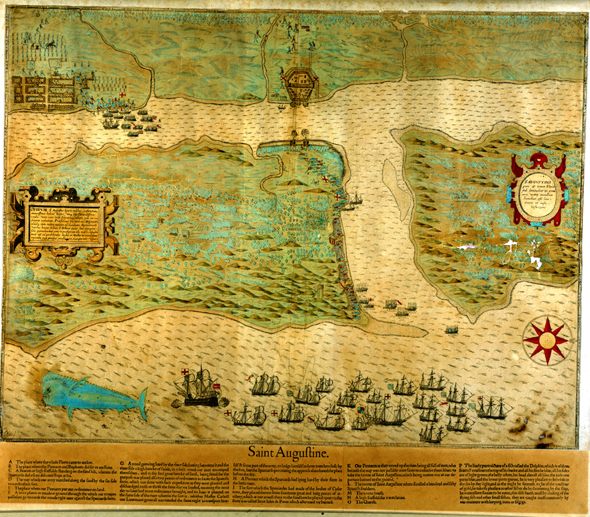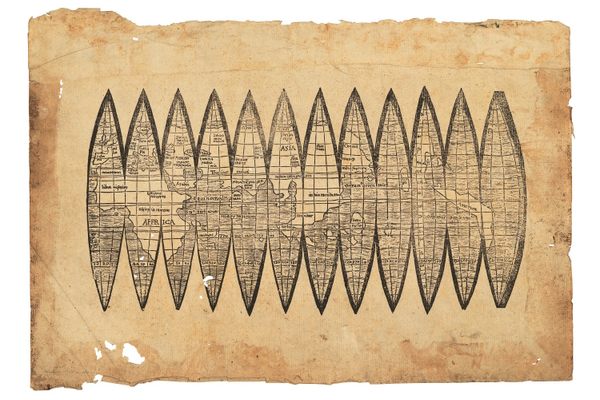The Gift America Didn’t Know It Wanted: Florida
 An engraved map of Florida by artist Jacques les Moyne, from 1591. (Image: Library of Congress/Public Domain)
An engraved map of Florida by artist Jacques les Moyne, from 1591. (Image: Library of Congress/Public Domain)
There’s no arguing it—Florida is kind of nuts. Pull on that lever sticking out from the bottom of the U.S., and you might get giant lobsters, presidential vacation bunkers, or neon homes adorned with bowling balls. But long before this country was even a twinkle in Washington’s eye, what would become the Sunshine State was packed with pioneers, insurgents, and all sorts of counterculture.
In fact, it was its status as a hotbed of rebellion that inspired Spain to give it to the United States on July 17th, 1821. In honor of the 194th anniversary of its handover, we rounded up eight crazy things Florida had to offer before it even joined the Union.
1. The First European Woman and African Man on the Continent
A painting of Juan Garrido and Hernando Cortes exploring Mexico in 1520. Garrido is also thought to be the the first person to plant wheat in the New World. (Image: Public Domain)
When King Ferdinand of Spain decided to check out some land north of Puerto Rico in 1512, he sent a man named Juan Ponce de Leon. Ponce de Leon was your average conquistador—he was born noble and cut his teeth as a “gentleman volunteer” on Columbus’s second New World expedition—but a small fraction of his crew was not average at all. The two-hundred-strong team that supported his first voyage included at least one European woman, named Juana Ruiz, and one West African man, Juan Garrido. Each is believed to be the first of their respective demographics to set foot on mainland North America.
2. Huge Droves of Feral Horses Wild horses enjoying their freedom in Florida. (Photo: Geoff Galice/WikiCommons CC BY 2.0)
Wild horses enjoying their freedom in Florida. (Photo: Geoff Galice/WikiCommons CC BY 2.0)
To help them herd cattle, draw plows, and generally get around, optimistic conquistadors loaded their ships with stallions and mares from Spain. But the harsh realities of seafaring and colonizing meant that many of the animals were lost—not killed, but literally lost, freed on purpose during shipwrecks or abandoned after failed projects and explorations. Since prehistoric Floridians had eaten all the horses in the area, along with most other large mammals, ten thousand years earlier, the newcomers had no competition, so they took over Florida, where many of their descendants still roam free today.
3. The Oldest City in the U.S. A 1589 map of St. Augustine, by Baptista Boazio. (Image: WikiCommons PD-US)
A 1589 map of St. Augustine, by Baptista Boazio. (Image: WikiCommons PD-US)
In 1565, half a century after Spain claimed Florida, the territory’s first governor established the city of St. Augustine. What started out as a thrown-together settlement quickly became a conflict magnet—over the next few centuries, it was burned, raided, and temporarily conquered by American Indian tribes, French armies, and English pirates. But it also started racking up milestones: the first child of European descent to be born in what is now the continental United States joined the world in St. Augustine, as did the first African-American child. St. Augustine currently boasts an airplane graveyard, the country’s narrowest street,and a number of intertwined, interspecies love trees. Most impressively, though, it outlasted the early attacks (and more recent snowbirds) to become the oldest continuously occupied city in the United States.
4. The First Settlement of Ex-Slaves Fort Mose is now a state park. (Image: Justin Waters/WikiCommons CC BY-SA 4.0)
Fort Mose is now a state park. (Image: Justin Waters/WikiCommons CC BY-SA 4.0)
In the late 17th century, the Spanish government began offering official asylum to all slaves who managed to escape the British colonies and get to Florida, provided they agreed to convert to Catholicism and serve in the Spanish military. The newly free (or free-er) people settled in a town called Gracia Real de Santa Teresa de Mosé, a.k.a. Fort Mose. The fort was home to hundreds, and is now considered a precursor to the Underground Railroad.
5. Rowdy Rebels
In 1780, the British arrested three signers of the Declaration of Independence. They sent them to St. Augustine, where they were held in this prison, the Castillo de San Marcos. (Photo: Historic American Buildings Survey/Public Domain)
Spain traded Florida to Britain in 1763 in exchange for Havana. Most of the Spanish and freed people promptly left for Cuba, and the British went about repopulating with their own settlers, planting more lucrative crops, and establishing order in the form of more regimented legal and political systems. A mere 13 years later, though, the rest of America threatened to upset that nice new order by declaring the War of Independence. Floridians didn’t care for the idea—they had no complaints about the motherland, and when they got wind of the Declaration of Independence, the people of St. Augustine burned effigies of the Founding Fathers in a public square. And so Florida became a Loyalist mecca, full of anti-revolutionaries: the most rebellious stance possible in post-1776 America.
6. Florida Crackers Renowned painter Frederic Remington’s depiction of a “cracker cowboy.” (Image: WikiCommons/Public Domain)
Renowned painter Frederic Remington’s depiction of a “cracker cowboy.” (Image: WikiCommons/Public Domain)
When the Treaty of Paris established the United States as a new country in 1783, Spain regained control of Florida. Soon after, Americans from Georgia and South Carolina begun illegally crossing the border, and setting up small outlaw communities. Known as the “Florida Crackers,” likely due to their wisecracking ways, many among this “lawless set of rascalls” ended up training those feral horses from before and working as cowboys.
7. “The Free and Independent Republic of West Florida” The “Bonnie Blue Flag” of the Free and Independent Republic of West Texas was later co-opted by Confederates. (Image: Project Gutenberg/Public Domain)
The “Bonnie Blue Flag” of the Free and Independent Republic of West Texas was later co-opted by Confederates. (Image: Project Gutenberg/Public Domain)
The early 19th century saw the U.S. using the Louisiana Purchase and land-dispute legislation to annex small areas of Florida, but much of it remained under Spanish rule. In 1810, disgruntled British and American Floridians took matters into their own hands and successfully attacked a Spanish fort, raising a new flag and declaring the area “The Free and Independent Republic of West Florida.” Although the Republic was technically in what is now Louisiana, it was that Florida spirit that drove the rebels, who kept their new country alive for ninety days before it was scooped up by the U.S.
8. Abolitionist American Indians
The United States went to war with the Florida Seminoles numerous times. In this painting, Marines search Florida mangroves. (Image: NARA Archive/Public Domain)
After Fort Mose closed, the Seminole and Creek tribes picked up the slack, welcoming runaway slaves into their communities. When officials ordered their return, Seminoles reportedly responded that they “had merely given hungry people food, and invited the slaveholders to catch the runaways themselves.” Partially because of this, the American colonies began warring with Floridian Indians in the 1810s, and Secretary of State John Quincy Adams declared the whole territory “a derelict, open to the occupancy of every enemy, civilized or savage, of the United States and serving no other earthly purpose, than as a post of annoyance to them.” He convinced Spain to give up Florida to the United States so that they could tame it; on July 17th, 1821, the reins were officially passed.
Luckily, 194 years later, Florida remains just about as feral as ever. Just ask the Keys Alligators.
Update, 7/18: St. Augustine is not the overall oldest city in the U.S., it is the oldest continuously occupied city. The article has been corrected to reflect this. We regret the error.










Follow us on Twitter to get the latest on the world's hidden wonders.
Like us on Facebook to get the latest on the world's hidden wonders.
Follow us on Twitter Like us on Facebook